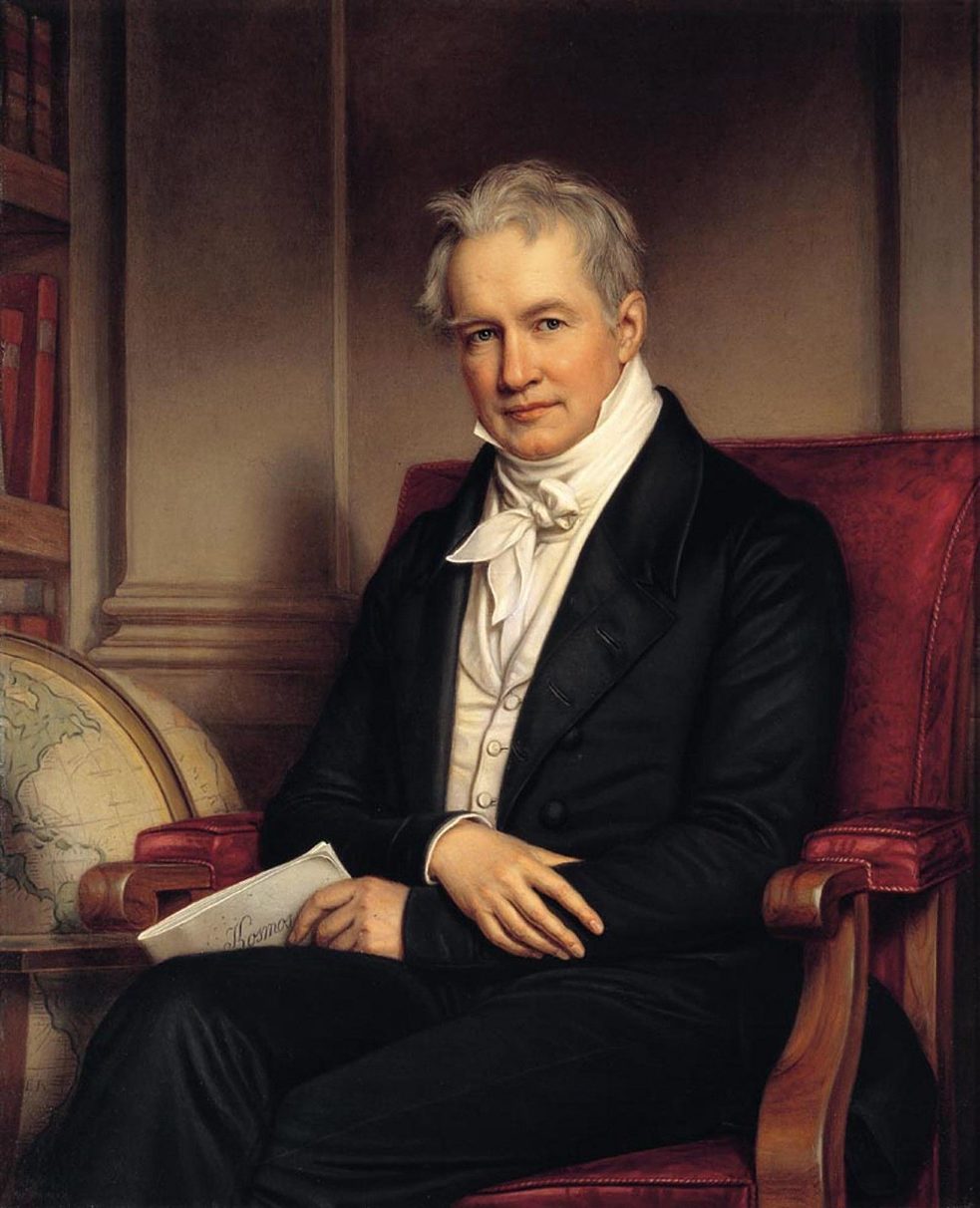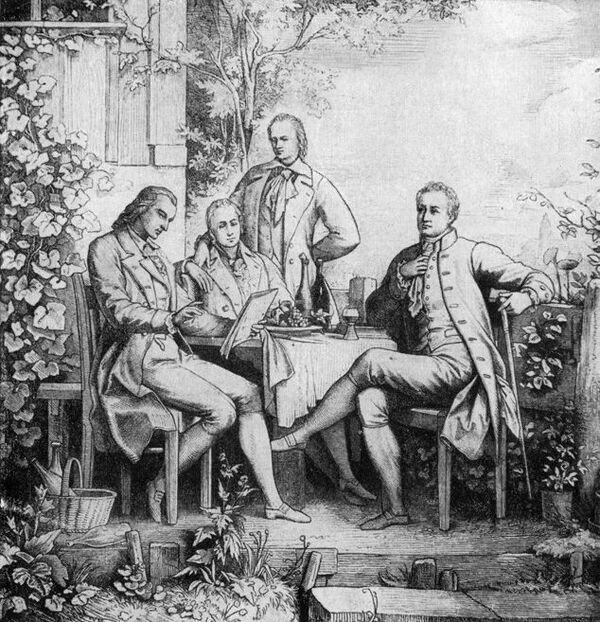Did you know...?
Ten facts about
Alexander von Humboldt

In 2019, the Humboldt-year, we celebrated the 250th birthday of the German natural scientist Alexander von Humboldt. On this occasion we have collected the most important facts about him and his life.
By Swantje Schütz
 Alexander von Humboldt, Painting by Joseph Stieler, 1843
| Wikimedia, Public Domain
Son from a good family
Alexander von Humboldt, Painting by Joseph Stieler, 1843
| Wikimedia, Public Domain
Son from a good family
For the era, Alexander von Humboldt lived a long life. He died unmarried at the age of 89 in 1859 in Berlin, his birthplace. Born in 1769, he was the second child of a royal Prussian family. The later King Friedrich Wilhelm II was one of Alexander's godfathers. Alexander's father was a Prussian officer, his mother came from a Huguenot family and brought a son from her first marriage. In this prosperous environment, the brothers Wilhelm and Alexander von Humboldt were raised to join the ranks of the educated class – this was the basis of their thirst for knowledge. For Alexander is not the only famous person - his brother Wilhelm was one of the most important humanities scholars and educationalists in Germany.
Important stages
Born in Berlin, studied in Frankfurt an der Oder, worked in the state mining industry as a civil servant assessor - until 1796 there was nothing to suggest that Humboldt would one day be described by his contemporaries as the most famous man in the world after Napoleon. Yet after leaving the civil service – and an inherited gained - he devoted himself exclusively to research. From 1799 to 1804 he travelled through Latin America. During this time, he made three major expeditions, including the ascent of the Chimborazo volcano at 6,310 metres. Back in Europe he lived in Paris and Berlin. In 1829, another trip to Russia followed, lasting several months, until he finally returned to Prussia - as a scientist, but also temporarily as a diplomat on behalf of the Prussian king.
 Alexander von Humboldt, Painting by Friedrich Georg Weitsch, 1806
| Wikimedia, Public Domain
Contemporaries
Alexander von Humboldt, Painting by Friedrich Georg Weitsch, 1806
| Wikimedia, Public Domain
Contemporaries
Alexander von Humboldt was born in 1769 during the time of the Enlightenment. Inventions and discoveries shaped the end of the 18th and the beginning of the 19th century. Scholars like Immanuel Kant, Arthur Schopenhauer, Johann Wolfgang von Goethe and Friedrich Schiller were among Humboldt's contemporaries. Carl Friedrich Gauss developed physics further, Alessandro Volta and Michael Faraday were making advancements in the field of electricity. The Englishman Charles Darwin investigated the biological origins of man, the Frenchman Louis Pasteur created the foundations of microbiology. But the culture of that time was also formative: the works of Wolfgang Amadeus Mozart and Ludwig van Beethoven also date from this epoch.
Humboldt and Goethe - Natural scientist meets natural scientist
With Johann Wolfgang von Goethe one thinks of poetry, of The Sorrows of Young Werther - or of the Goethe-Institut. But not of natural research. Yet Goethe was an enthusiastic natural scientist - and therefore a friend of Humboldt, who was ten years younger. The two met in Jena in 1794 through Alexander's brother Wilhelm. Humboldt was still inspecting mines at the time, Goethe was already Germany's most famous poet and felt very much inspired by Humboldt's versatility. The inspiration was mutual: Humboldt learned from Goethe not only to deal with nature through his instruments, but also to understand it in an emotional way.
 Friedrich Schiller, Alexander von Humboldt and Johann Wolfgang von Goethe in Jena
| Wikimedia, Public Domain
Universal scholar
Friedrich Schiller, Alexander von Humboldt and Johann Wolfgang von Goethe in Jena
| Wikimedia, Public Domain
Universal scholar
Languages were not his thing - one would say today. The young Humboldt - in contrast to his linguistically gifted brother - was very interested in the natural sciences, especially botany, but also geology, physics and oceanology. He was a universal scholar who viewed the earth as a coherent whole. He discovered climatic zones, used a wide range of modern measuring instruments and advocated for the abolition of slavery. Nature had to be experienced and felt, was his opinion, and this at a time when other scientists were searching rather, for universal laws. One of his aims was that all men should love nature as he did.
Humboldt as namesake
Animals, plants, rivers, mountains, asteroids - often Alexander von Humboldt is the namesake. Whether it is the famous Humboldt Penguin, the gigantic Humboldt Current or the relatively unknown yeast fungus Pichia humboldtii, the researcher was the godfather. His name is borne by 19 animal species, 17 plants, two glaciers, eight mountains and ranges, a river, two asteroids, a sea of the moon, a moon crater, an airport and countless schools. Together with his brother Wilhelm, he is also the namesake of the renowned Humboldt University in Berlin.
 The Humboldt penguin (Spheniscus humboldti), named after the naturalist, whom he is said to have observed in present-day Peru.
| Wikimedia, GNU Free Documentation License
Humboldt and Latin America
The Humboldt penguin (Spheniscus humboldti), named after the naturalist, whom he is said to have observed in present-day Peru.
| Wikimedia, GNU Free Documentation License
Humboldt and Latin America
In Latin America Humboldt is not only respected, he is almost revered, often as a hero of the people. As a true humanist, he respected everyone, no matter where they came from or what they looked like. As a knowledgeable mining assessor, he went down into the mines in Latin America, down to the deepest brine. What he saw horrified him, especially in New Spain, today's Mexico. The cruel conditions for the indigenous population working underground were unacceptable to him. In Mexico, Humboldt is theretofore regarded as part of the independence movement and as one of the country's founding fathers. In Cuba, he is still revered for his advocacy against slavery. And in Venezuela, he is still known amongst the farmers of the Chaima people, because he once took action against the Catholic Church and its methods of oppression.
 Humboldt with researcher friend Aimé Bonpland in front of the Chimborazo
| Wikimedia, Public Domain
The Mountain
Humboldt with researcher friend Aimé Bonpland in front of the Chimborazo
| Wikimedia, Public Domain
The Mountain
Humboldt travelled thousands of kilometres in his life, but 5,917 metres remained in his memory in particular: due to his climb of Chimborazo, which at 6,310 metres was at that time considered to be highest mountain in the world. In 1802, with poor equipment, Humboldt and party marched towards the summit of the inactive volcano in present-day Ecuador. At 5,400 metres, altitude sickness broke out. The mountaineers bled and suffered dizzy spells, but nevertheless they dragged themseves on. At 3031 toisen, that is 5,917 meters, it was over - a crevasse prevented them from moving on. But why did Humboldt even climb this mountain? He wanted to prove that the enormous firepower inside the earth shapes its surface. He was convinced by the rock near the summit: it reminded him of coal. The daring tour was not carried out for the sake of mountaineering fame, but for nature research. He never forgot this ordeal. Shortly before his death in 1859, he had his portrait painted in Berlin - with Chimborazo in the background.
 Volcano Chimborazo in today's Ecuador
| David Torres Costales, Wikimedia, CC-SA-3.0
The great communicator
Volcano Chimborazo in today's Ecuador
| David Torres Costales, Wikimedia, CC-SA-3.0
The great communicator
What do you do if you want to share your knowledge, but Wikipedia has not yet been invented? How do you build a worldwide network without Facebook? You write letters. Many letters. At least that's what Alexander von Humboldt thought. In total he wrote almost 50,000 letters. So on average two letters a day. In this way he exchanged ideas with other scientists, documented his findings, and shared his research results - 200 years before today's Sharing Economy. Based on the 13,000 letters still extant today, the size of his network can be estimated at around 2,500 writers and recipients.
Cosmos
Everything is connected to everything else. But what does that mean - and what does it have to do with Humboldt? Humboldt was the first to document climactic and vegetation zones. He proved that at the appropriate altitude in mountains the vegetation is similar worldwide. He also proved that there are climate zones, where they are located and what effect they have on growth. He recognized the change in climate caused by man, by deforestation, by artificial irrigation and by gas and heat emissions in industrial centers. In his most influential work, the four-volume Kosmos, Entwurf einer physische Weltbeschreibung (1845-1862), Alexander von Humboldt summarized his scientific findings - with the support of numerous experts.The historian Andrea Wulf has analysed the researcher and, in an interview with the German magazine Stern, concludes: "He was the first environmentalist on our planet. The father of the environmental movement, the man who discovered that humans can change the climate".
Comments
Comment